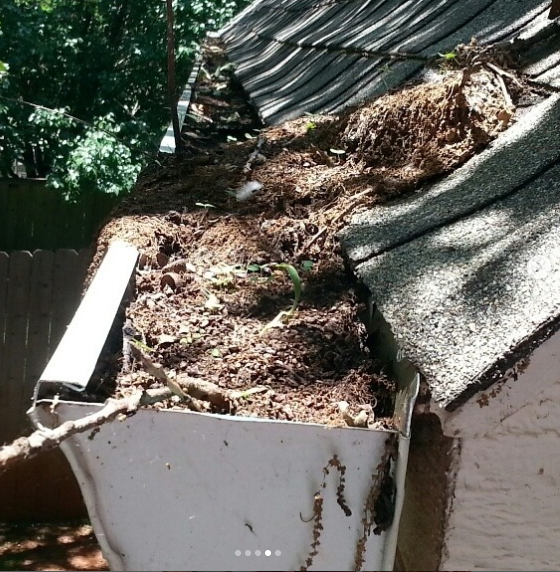Downspout cleaning is often overlooked, but it is essential for home maintenance. Neglecting it can lead to water damage, pest infestations, and slippery walkways. Regular cleaning, twice a year in spring and fall, is recommended to prevent hazards.
In this blog post, we’ll discuss the tools and materials you’ll need, step-by-step instructions for cleaning downspouts, and tips for preventing clogs in the future. We’ll cover everything from manual cleaning with a trowel or scoop to using a gutter cleaning robot. So let’s get started!
Why Downspout Cleaning is Important
Downspout cleaning is an essential part of home maintenance that is often overlooked. Neglecting downspout maintenance can have serious consequences, such as water damage to the foundation, roof, or siding, or pest infestations. Water damage can be expensive to repair and can lead to mold growth, which can be hazardous to your health. Pest infestations can be a nuisance and can cause damage to your home.
When gutters and downspouts are blocked with leaves and debris, rainwater may not drain properly. As water overflows from gutters, it can cause water damage on both the interior and exterior of your home. Water damage can cause cracks in the foundation of the house, damaged fascia boards, and damaged roofs. In addition to water damage, clogged gutters can also lead to dirty walls, windows, and doors.

Clogged gutters and downspouts can also pose a risk of slips and falls. The water overflowing from clogged gutters can create a slippery surface on walkways, which can lead to accidents. It’s important to get your gutters and downspouts cleaned regularly to prevent these hazards.
Summer storms can also cause debris to collect in your gutters, which can lead to blockages. Getting professional gutter and downspout cleaning will ensure that there’s never too much weight tugging at your gutters. To maintain your gutters clear and free-flowing, it’s recommended to clean them twice a year in spring and fall. The drainage system of a multi-story building taller than nearby trees should be cleaned at least once a year.
Tools and Materials Needed for Cleaning Downspouts
There are various tools and materials that you will need to clean your downspouts effectively, including gloves, a ladder, a trowel, a bucket, a hose, and possibly a power washer or plumber’s snake.
Gutter Scoop
One of the essential tools for cleaning downspouts is a gutter scoop or spoon. This inexpensive tool is made from sturdy materials and is easy to use. It is designed to scoop up or push debris out of gutters before it gets to the downspouts, but it is not strong enough to tackle heavier or built-up debris.
Gutter Cleaning Tongs
Another tool is gutter cleaning tongs, which are adjustable to almost any height when used with an extension pole. They are designed to pick out even small items such as pine needles, but they may not fully clear out heavy or stuck-on debris.
Telescopic Pole
Telescopic pole attachments are also an excellent option for cleaning downspouts, especially for those who do not want to balance on a ladder. These poles extend from 40 to 90 inches, making it easy to reach even the highest downspouts from the ground. However, they may not be powerful enough to clear out excessive or stuck-on debris, and they can be prone to breaking easily.
Leaf Blower
If you already own a wet/dry vac or leaf blower, you can invest in the gutter cleaning kit that is sold separately. This attachment works best with handheld vacuum and leaf blower models, as opposed to units that plug into an outlet. It is flexible and allows access to awkward angles and tight spots.
Gutter Cleaning Robot
Finally, if you want to completely outsource gutter and downspout cleaning, you can consider using a gutter cleaning robot. These robots are designed to get into even the smallest spaces to blast away dirt and debris, while you watch safely from below. They are easily controlled with a handheld remote and come with customizable auger ejectors to fit different gutter sizes.
Step by Step for Downspout Cleaning
In regards to downspout cleaning, it’s important to set up a safe and efficient workspace. Before you begin, check the weather forecast to ensure that conditions are favorable. Next, secure your ladder properly to prevent any accidents. Wear protective gear, such as gloves and eye goggles, to protect yourself from debris and water splashes.
Inspect Your Downspouts
Once you’re ready to inspect your downspouts, start by visually examining them for signs of blockages. Look for debris buildup, such as leaves, twigs, or dirt, and identify potential problem areas. Pay attention to any leaks, cracks, or rusty spots, as these could indicate structural damage.
Clearing Your Downspouts Manually
To clear any blockages manually, use a trowel or hand-held scoop to remove clogs and buildup from the downspout. It’s important to use proper technique and take safety precautions, such as wearing gloves and avoiding overreaching.
Flush the Downspouts
After manually removing any debris, it’s time to flush the downspout with water. Use a garden hose or pressure washer to flush the downspout from the top down. This will break up any remaining blockages and test the water flow. If water is still flowing over the edges of your gutters, you may need to clear the downspout again or consider calling in a professional.
Preventing Downspout Clogs in the Future

Preventing downspout clogs and maintaining good water flow through your gutters and downspouts is important to protect your home from water damage. Here are some tips to help you keep your downspouts clean and in good working order:
Clean your downspouts and gutters more often: Regular inspections and cleaning of your gutters and downspouts can help prevent clogs from forming. Make sure to clean not only the vertical downspouts but also the horizontal elbows and extensions, which can be tricky to access but prone to clogging. If a significant windstorm has just passed, it is wise to make an exception and inspect your system the day after.
Trim trees and tall hedges away from your roof’s edge: Leaves, twigs, and other debris that clog gutters often come from nearby trees and bushes. To reduce the amount of debris that accumulates in your gutters, trim trees and hedges back at least eight feet away from your roof’s edge.
Remove potential airborne debris: Loose shingles and roof/chimney material can trickle down into your gutters and plug your downspouts. Have your roof inspected and replace sections or make repairs where needed, as soon as an issue is uncovered. Keep your yard clean and your garbage/recycle bins sealed tight to cut off all potential for future problems.
Install gutter guards: Installing leaf guards on your gutter system is an essential accessory that can prevent anything (but rainwater) from entering your gutters, reducing the likelihood of downspout blockages.
Upgrade to premium grade gutters: Investing in a premium gutter system made of copper, zinc, aluminum, or steel can be a good long-term solution to keeping clogs at bay. Such a system will maintain adequate rainwater flow, filtering leaves and debris through the carriage and seamlessly into the downspouts more effectively than a lesser system.
It is important to remember that sometimes it may be necessary or advisable to seek the help of a professional downspout cleaner, especially for very high or steep roofs, complex gutter systems, or persistent clogs. Following these guidelines for maintaining your downspouts can help you avoid water damage to your home and save you money in the long run.
Frequently Asked Questions
Why is downspout cleaning important?
Downspout cleaning is important to prevent water damage to your home’s foundation, roof, or siding, as well as pest infestations. Neglecting downspout maintenance can lead to costly repairs and mold growth, which can be hazardous to your health.
What tools and materials are needed for cleaning downspouts?
The tools and materials needed for cleaning downspouts include gloves, a ladder, a trowel, a bucket, a hose, and possibly a power washer or plumber’s snake. Other helpful tools include a gutter scoop, gutter cleaning tongs, a telescopic pole, a leaf blower, and a gutter cleaning robot.
How can you prevent downspout clogs in the future?
You can prevent downspout clogs and maintain good water flow through your gutters and downspouts by cleaning them regularly, including the horizontal elbows and extensions. You can also install gutter guards or screens to prevent debris buildup and reduce the frequency of cleaning. Additionally, trimming nearby trees and plants can reduce the amount of debris that falls into your gutters.




2 thoughts on “How to Clean Downspouts: Step-by-Step Guide”